Name Matoaka | Children Thomas Rolfe | |
 | ||
Full Name Matoaka, later known as Amonute Other names Matoakalater known as Amonutemarried name Rebecca Rolfe Known for Association with Jamestown colony, saving the life of John Smith, and as a Powhatan convert to Christianity Religion Anglicanism (converted from Native American religion) Died March 1617, Gravesend, United Kingdom Parents Powhatan, Nonoma Winanuske Matatiske Similar People | ||
The Real Native History of Pocahontas - From a Native Journalist
Pocahontas (born Matoaka, known as Amonute, c. 1596–1617) was a Native American woman notable for her association with the colonial settlement at Jamestown, Virginia. Pocahontas was the daughter of Powhatan, the paramount chief of a network of tributary tribal nations in the Tsenacommacah, encompassing the Tidewater region of Virginia. In a well-known historical anecdote, she is said to have saved the life of a captive of the Native Americans, the Englishman John Smith, in 1607 by placing her head upon his own when her father raised his war club to execute him. Some historians have suggested that this story, as told by Smith, is untrue.
Contents
- The Real Native History of Pocahontas From a Native Journalist
- Pocahontas l air du vent
- Early life
- Names
- Title and status
- John Smith
- Capture
- Possible first marriage
- Marriage to John Rolfe
- England
- Death
- Descendants and legacy
- Cultural representations
- On stage
- In dramatizations
- Commemorations
- In films
- In games
- In literature
- In music
- In visual art
- Animals
- Companies
- Places
- Schools
- Transport
- References
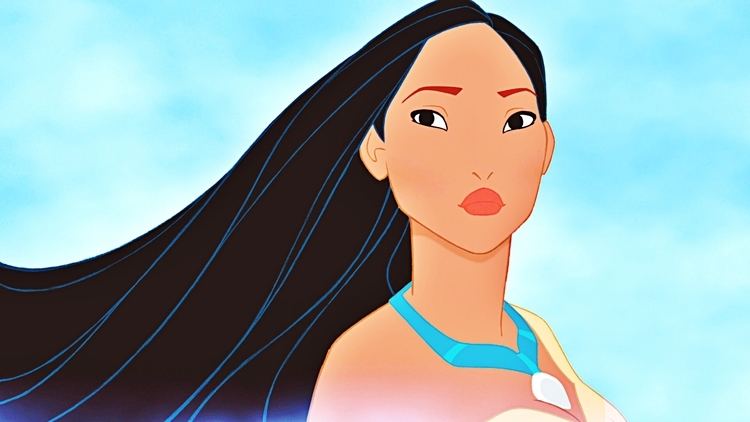
Pocahontas was captured by the English during Anglo-Indian hostilities in 1613, and held for ransom. During her captivity, she converted to Christianity and took the name Rebecca. When the opportunity arose for her to return to her people, she chose to remain with the English. In April 1614, she married tobacco planter John Rolfe, and in January 1615, bore their son, Thomas Rolfe.
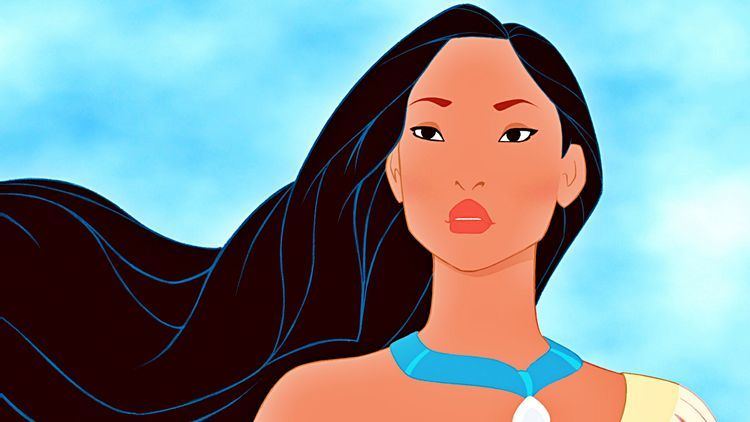
In 1616, the Rolfes traveled to London. Pocahontas was presented to English society as an example of the "civilized savage" in hopes of stimulating investment in the Jamestown settlement. She became something of a celebrity, was elegantly fêted, and attended a masque at Whitehall Palace. In 1617, the Rolfes set sail for Virginia, but Pocahontas died at Gravesend of unknown causes. She was buried in St George's Church, Gravesend in England, but the exact location of her grave is unknown, as the church has been rebuilt.
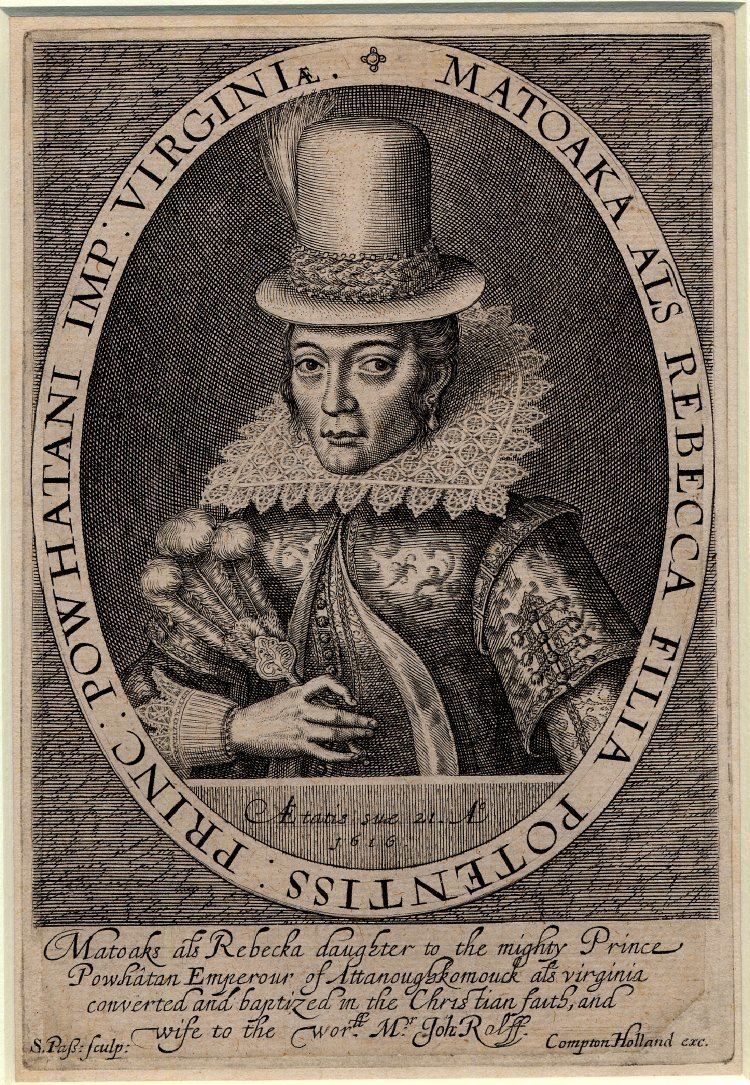
Numerous places, landmarks, and products in the United States have been named after Pocahontas. Her story has been romanticized over the years, and she is a subject of art, literature, and film. Many famous people have claimed to be among her descendants through her son Thomas, including members of the First Families of Virginia, First Lady Edith Wilson, American Western actor Glenn Strange, and astronomer Percival Lowell.
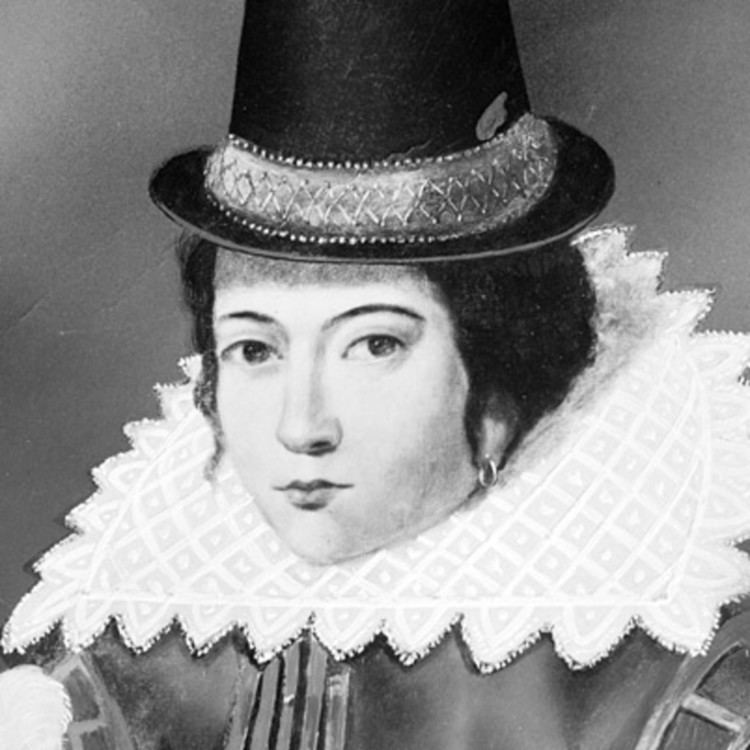
Pocahontas l air du vent
Early life

Pocahontas' birth year is unknown, but some historians estimate it to have been around 1596. In A True Relation of Virginia (1608), Smith described the Pocahontas he met in the spring of 1608 as being "a child of ten years old". In a letter written in 1616, he again described her as she was in 1608, but this time as "a child of twelve or thirteen years of age".
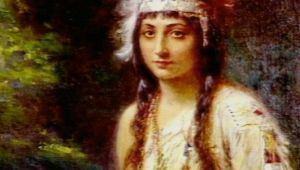
Pocahontas was the daughter of Powhatan, paramount chief of Tsenacommacah, an alliance of about thirty Algonquian-speaking groups and petty chiefdoms in Tidewater, Virginia. Her mother's name and origins are unknown but she was probably of lowly status. The colonist Henry Spelman, who had lived among the Powhatan as an interpreter, noted that when one of the paramount chief's many wives gave birth to a child, the mother was returned to her place of origin, to be supported there by the paramount chief until she found another husband. In the traditional histories of the Powhatan, Pocahontas' mother died in childbirth.
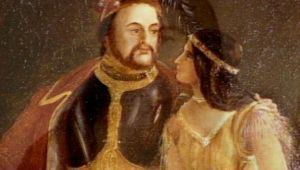
Pocahontas' childhood was probably little different from that of most girls who lived in Tsenacommacah. She learned how to perform what was considered to be women's work, which included foraging for food and firewood, farming, and searching for the plant materials used in building thatched houses. As she grew older, she helped other members of Powhatan's household with preparations for large feasts. Serving feasts, such as the one presented to John Smith after his capture, was a regular obligation of the Mamanatowick, or paramount chief.
Names

At the time Pocahontas was born, it was common for Powhatan Native Americans to be given several personal names, have more than one name at the same time, have secret names that only a select few knew, and to change their names on important occasions. Bestowed at different times, the names carried different meanings and might be used in different contexts. Pocahontas was no different. Early in her life she was given a secret name, Matoaka, but later she was also known as Amonute. Matoaka means "Bright Stream Between the Hills"; Amonute cannot be translated.
The name Pocahontas was a childhood nickname that probably referred to her frolicsome nature; according to the colonist William Strachey, it meant "little wanton"; some interpret the meaning as "playful one". The 18th-century historian William Stith claimed that "her real name, it seems, was originally Matoax, which the Indians carefully concealed from the English and changed it to Pocahontas, out of a superstitious fear, lest they, by the knowledge of her true name, should be enabled to do her some hurt." According to the anthropologist Helen C. Rountree, Pocahontas "revealed [her secret name] to the English only after she had taken another religious—baptismal—name, Rebecca".
Pocahontas' Christian name, Rebecca, may have been a symbolic gesture to Rebecca of the Book of Genesis who, as the mother of Jacob and Esau, was the mother of two "nations", or distinct peoples. Pocahontas, as a Powhatan marrying an Englishman, may have been seen by herself and by her contemporaries as being also, potentially, a matriarchal figure of two distinct peoples.
Title and status
Pocahontas has been considered in popular culture to be a princess. In 1841, William Watson Waldron of Trinity College, Dublin, in Ireland, published Pocahontas, American Princess: and Other Poems, calling Pocahontas "the beloved and only surviving daughter of the king". Indeed, Pocahontas was a favorite of her father's—his "delight and darling", according to the colonist Captain Ralph Hamor—but she was not in line to inherit a position as a weroance, subchief, or mamanatowick (paramount chief). Instead, Powhatan's brothers, sisters, and his sisters' children all stood in line to succeed him. In his A Map of Virginia John Smith explained how matrilineal inheritance worked among the Powhatans:
His [Powhatan's] kingdom descendeth not to his sonnes nor children: but first to his brethren, whereof he hath three namely Opitchapan, Opechanncanough, and Catataugh; and after their decease to his sisters. First to the eldest sister, then to the rest: and after them to the heires male and female of the eldest sister; but never to the heires of the males.
John Smith
Pocahontas is most famously linked to the English colonist Captain John Smith, who arrived in Virginia with a hundred other settlers in April 1607, at the behest of the London Company. After building a fort on a marshy peninsula poking out into the James River, the Englishmen had numerous encounters over the next several months with the Natives of Tsenacommacah, some of them friendly, some hostile. Then, in December 1607, while exploring on the Chickahominy River, Smith was captured by a hunting party led by Powhatan's younger brother (or close relative) Opechancanough and brought to Powhatan's capital at Werowocomoco. In his 1608 account, Smith describes a great feast followed by a long talk with Powhatan. He does not mention Pocahontas in relation to his capture, and claims that they first met some months later. Huber understands the meeting of Smith and Powhatan as the latter's attempt to bring Smith, and so the English, into his chiefdom: Powhatan offered Smith rule of the town of Capahosic, which was close to Powhatan's capital at Werowocomoco. The paramount chief thus hoped to keep Smith and his men "nearby and better under control".
In 1616, Smith wrote a letter to Queen Anne in anticipation of Pocahontas's visit to England. In this new account, his capture included the threat of his own death: "at the minute of my execution", he wrote, "she [Pocahontas] hazarded the beating out of her own brains to save mine; and not only that, but so prevailed with her father, that I was safely conducted to Jamestown." In his 1624 Generall Historie, published long after the death of Pocahontas, Smith expanded the story. Writing about himself in the third person, he explained that after he was captured and taken to the paramount chief, "two great stones were brought before Powhatan: then as many as could layd hands on him [Smith], dragged him to them, and thereon laid his head, and being ready with their clubs, to beate out his braines, Pocahontas the Kings dearest daughter, when no intreaty could prevaile, got his head in her armes, and laid her owne upon his to save him from death ..."
In a later publication, True Travels (1630), Smith claimed a similar rescue by another young girl in 1602, following his capture by Turks in Hungary; the story resembles a popular contemporary type of moral tale, in which a Christian hero maintains his faith despite threats and intimidation. Karen Ordahl Kupperman suggests that Smith used such details to embroider his first account, thus producing a more dramatic, second account of his encounter with Pocahontas as a heroine worthy of reception by Queen Anne. Its later revision and publication was probably an attempt to raise his own stock and reputation; he had long since fallen from favor with the Company that had funded the Jamestown enterprise. Gleach, drawing on substantial ethnohistory, suggests that Smith's second account, while substantially accurate, represents his misunderstanding of a three-stage ritual intended to adopt Smith, as representative of the English colony, into the confederacy; but not all writers are convinced, some suggesting the absence of certain corrborating evidence.
Early histories did establish that Pocahontas befriended Smith and the Jamestown colony. Pocahontas often went to the settlement and played games with the boys there. When the colonists were starving, "every once in four or five days, Pocahontas with her attendants brought him [Smith] so much provision that saved many of their lives that else for all this had starved with hunger". As the colonists expanded their settlement further, the Powhatan felt their lands were threatened, and conflicts arose again.
In late 1609, an injury from a gunpowder explosion forced Smith to return to England for medical care. The English told the Powhatans that Smith was dead. Pocahontas believed that account and hence afterward, stopped visiting Jamestown. Much later, she learned that he was living in England when she traveled there as the wife of John Rolfe.
Capture
Pocahontas's capture occurred in the context of the First Anglo-Powhatan War, a conflict between the Jamestown settlers and the Native Americans that began late in the summer of 1609. In the first years of war, the English took control of the James River, both at its mouth and at the falls. Captain Samuel Argall, in the meantime, pursued contacts with Native American groups in the northern portion of Powhatan's paramount chiefdom. The Patawomecks, who lived on the Potomac River, were not always loyal to Powhatan, and living with them was a young English interpreter named Henry Spelman. In March 1613, Argall learned that Pocahontas was visiting the Patawomeck village of Passapatanzy and living under the protection of the Weroance Iopassus (also known as Japazaws).
With Spelman's help translating, Argall pressured Iopassus to assist in Pocahontas's capture by promising an alliance with the English against the Powhatans. They tricked Pocahontas into boarding Argall's ship and held her for ransom, demanding the release of English prisoners held by her father, along with various stolen weapons and tools. Powhatan returned the prisoners, but failed to satisfy the colonists with the number of weapons and tools he returned. A long standoff ensued, during which the English kept Pocahontas captive.
During the year-long wait, she was held at Henricus, in modern-day Chesterfield County, Virginia. Little is known about her life there, although colonist Ralph Hamor wrote that she received "extraordinary courteous usage". Linwood "Little Bear" Custalow, in a 2007 book, asserted that Pocahontas was raped during this time, citing oral tradition handed down over four centuries. According to Helen Rountree, "Other historians have disputed that such oral tradition survived and instead argue that any mistreatment of Pocahontas would have gone against the interests of the English in their negotiations with Powhatan. A truce had been called, the Indians still far outnumbered the English, and the colonists feared retaliation."
At this time, the minister at Henricus, Alexander Whitaker, taught Pocahontas about Christianity and helped her to improve her English. Upon her baptism, Pocahontas took the Christian name "Rebecca".
In March 1614, the standoff built up to a violent confrontation between hundreds of English and Powhatan men on the Pamunkey River. At Powhatan's capital of Matchcot, the English encountered a group of senior Native American leaders. The English allowed Pocahontas to talk to her countrymen. When Powhatan arrived, Pocahontas reportedly rebuked him for valuing her "less than old swords, pieces, or axes", and said that she preferred to live with the English, "who loved her".
Possible first marriage
Current Mattaponi tradition holds that Pocahontas's first husband was Kocoum, brother of the Patawomeck weroance Japazaws, and that Kocoum was killed by the English after his wife's capture in 1613. Today's Patawomecks believe that Pocahontas and Kocoum had a daughter, Ka-Okee, who was raised by the Patawomecks after her father's death and her mother's abduction.
However, Kocoum's actual identity, location, and even existence have been widely debated among scholars for centuries, with several historians arguing that the only mention of a "Kocoum" in any English document is taken from a brief statement written c. 1616 by William Strachey in England that Pocahontas had been living married to a "private captaine called Kocoum" for two years. Since 1614 is certainly when she married John Rolfe, and no other records even hint at any previous husband, it has accordingly been suggested that when Strachey wrote of the "private captaine called Kocoum" he was mistakenly referring to Rolfe himself, with the reference being later misunderstood as one of Powhatan's officers. There was a Powhatan military rank called kokoraws, sometimes translated "captain", and scholarly debate has also raged whether Strachey could have meant this as one of his famously divergent spellings, as a gloss to "Captayne". In addition, the date of Strachey's original statement has been widely disputed by numerous authors attempting either to make the case, or refute, that Pocahontas had been previously married. If there was such a marriage and Kocoum was not murdered, it likely ended, according to Powhatan custom, when Pocahontas was captured.
Marriage to John Rolfe
During her stay in Henricus, Pocahontas met John Rolfe, whose English-born wife, Sarah Hacker, and child, Bermuda Rolfe, had died before he came to Virginia. Rolfe established a Virginia plantation, Varina Farms, where he successfully cultivated a new strain of tobacco. He was a pious man, and agonized over the potential moral repercussions of marrying a heathen. In a long letter to the governor requesting permission to wed her, he expressed his love for Pocahontas, and his belief that he would be saving her soul. He wrote that he was
motivated not by the unbridled desire of carnal affection, but for the good of this plantation, for the honor of our country, for the Glory of God, for my own salvation ... namely Pocahontas, to whom my hearty and best thoughts are, and have been a long time so entangled, and enthralled in so intricate a labyrinth that I was even a-wearied to unwind myself thereout
Pocahontas's feelings about Rolfe are unknown. They were married on April 5, 1614 by chaplain Richard Buck, probably at Jamestown. For two years they lived at Rolfe's plantation, Varina Farms, across the James River from Henricus. Their son Thomas was born on January 30, 1615.
Their marriage created a climate of peace between the Jamestown colonists and Powhatan's tribes; this lasted for eight years, and was called the "Peace of Pocahontas"; in 1615, Ralph Hamor wrote:
Since the wedding we have had friendly commerce and trade not only with Powhatan but also with his subjects round about us.
England
The Virginia Company of London had long seen one of its primary goals as the conversion of Native Americans to Christianity. With the conversion of Pocahontas and her marriage to an Englishman – all of which helped bring an end to the First Anglo-Powhatan War – the company saw an opportunity to promote investment. The company decided to bring Pocahontas to England as a symbol of the tamed New World "savage" and the success of the Jamestown settlement. In 1616, the Rolfes traveled to England, arriving at the port of Plymouth on June 12. They journeyed to London by coach, accompanied by a group of about eleven other Powhatans, including a holy man named Tomocomo. John Smith was living in London at the time and while Pocahontas was in Plymouth, she learned he was still alive. Smith did not meet Pocahontas, but wrote to Queen Anne, the wife of King James, urging that Pocahontas be treated with respect as a royal visitor. He suggested that if she were treated badly, her "present love to us and Christianity might turn to ... scorn and fury", and England might lose the chance to "rightly have a Kingdom by her means".
Pocahontas was entertained at various society gatherings. On January 5, 1617, she and Tomocomo were brought before the king at the old Banqueting House in the Palace of Whitehall at a performance of Ben Jonson's masque The Vision of Delight. According to Smith, King James was so unprepossessing that neither Pocahontas nor Tomocomo realized whom they had met until it was explained to them afterward.
Although Pocahontas was not a princess in the context of Powhatan culture, the Virginia Company nevertheless presented her as a princess to the English public. The inscription on a 1616 engraving of Pocahontas, made for the company, reads: "MATOAKA ALS REBECCA FILIA POTENTISS : PRINC : POWHATANI IMP:VIRGINIÆ", which means: "Matoaka, alias Rebecca, daughter of the most powerful prince of the Powhatan Empire of Virginia". Many English at this time recognized Powhatan to be the ruler of an empire, and they presumably accorded to his daughter what they considered appropriate status. Smith's letter to Queen Anne refers to "Powhatan their chief King". Samuel Purchas recalled meeting Pocahontas in London, writing that she impressed those she met because she "carried her selfe as the daughter of a king". When he met her again in London, Smith referred to Pocahontas deferentially as a "Kings daughter".
Pocahontas was apparently treated well in London. At the masque, her seats were described as "well placed", and, according to Purchas, John King, Bishop of London, "entertained her with festival state and pomp beyond what I have seen in his greate hospitalitie afforded to other ladies".
Not all the English were so impressed. According to Helen C. Rountree, "there is no contemporary evidence to suggest ... that Pocahontas was regarded [in England] as anything like royalty". Rather, she was considered to be something of a curiosity and, according to one observer, she was merely "the Virginian woman".
Pocahontas and Rolfe lived in the suburb of Brentford, Middlesex, for some time, as well as at Rolfe's family home at Heacham Hall, Heacham, Norfolk. In early 1617, Smith met the couple at a social gathering, and later wrote that when Pocahontas saw him, "without any words, she turned about, obscured her face, as not seeming well contented", and was left alone for two or three hours. Later, they spoke more; Smith's record of what she said to him is fragmentary and enigmatic. She reminded him of the "courtesies she had done", saying, "you did promise Powhatan what was yours would be his, and he the like to you". She then discomfited him by calling him "father", explaining Smith had called Powhatan "father" when a stranger in Virginia, "and by the same reason so must I do you". Smith did not accept this form of address because, he wrote, Pocahontas outranked him as "a King's daughter". Pocahontas then, "with a well-set countenance", said:
Were you not afraid to come into my father's country and caused fear in him and all his people (but me) and fear you here I should call you "father"? I tell you then I will, and you shall call me child, and so I will be for ever and ever your countryman.
Finally, Pocahontas told Smith that she and her fellow Native Americans had thought him dead, but her father had told Tomocomo to seek him "because your countrymen will lie much".
Death
In March 1617, John Rolfe and Pocahontas boarded a ship to return to Virginia; the ship had sailed only as far as Gravesend on the river Thames, when Pocahontas became gravely ill. She was taken ashore and died at the approximate age of 21. It is not known what caused her death, but theories range from pneumonia, smallpox, or tuberculosis, to her having been poisoned. According to Rolfe, she died saying, "all must die, but tis enough that her child liveth". Her father Powhatan died within a year of Pocahontas, and after this, the "Peace of Pocahontas" began to disintegrate.
Pocahontas' funeral took place on March 21, 1617, in the parish of Saint George's, Gravesend. Her grave is thought to be underneath the church's chancel, though since that church was destroyed in a fire in 1727, her exact gravesite is unknown. Her memory is honored with a life-size bronze statue at St. George's Church by William Ordway Partridge.
Descendants and legacy
Pocahontas and her husband, John Rolfe, had one child, Thomas Rolfe, who was born in January 1615. The following year, Thomas' parents traveled to London.
Pocahontas and her father, Chief Powhatan, have many notable descendants, including Edith Bolling Galt Wilson (Woodrow Wilson's wife), American Western actor Glenn Strange, astronomer and mathematician Percival Lowell and members of the First Families of Virginia including George Wythe Randolph, Admiral Richard E. Byrd, and Virginia Governor Harry F. Byrd.
In 1907, Pocahontas became the first Native American to be honored on a US stamp. She was a member of the inaugural class of Virginia Women in History in 2000.
In July 2015, the Pamunkey Indian Tribe, descendants of the Powhatan chiefdom, of which Pocahontas was a member, became the first federally recognized tribe in the state of Virginia.
Cultural representations
After her death, increasingly fanciful and romanticized representations of Pocahontas were produced, in which Pocahontas and Smith were romantically involved. Contemporary sources substantiate claims of their friendship, not a romance. The first claim of their romantic involvement was in John Davis' Travels in the United States of America (1803)
On stage
In dramatizations
Commemorations
In films
Films about Pocahontas include:
